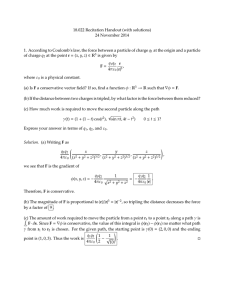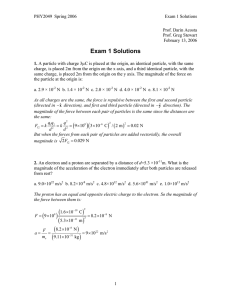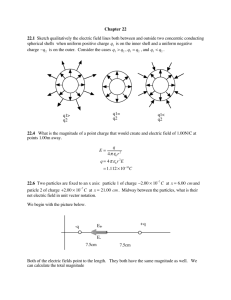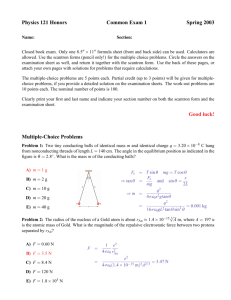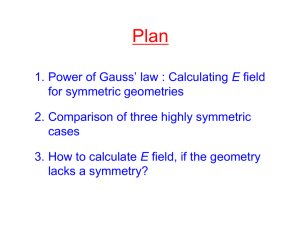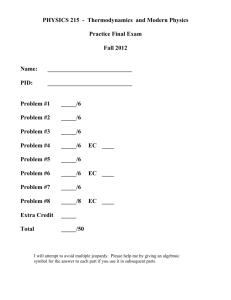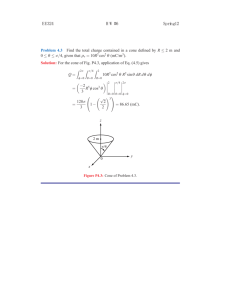PHY4324/Fall 09: EM II HOMEWORK ASSIGNMENT #8: Solutions Instructor: D. L. Maslov
advertisement
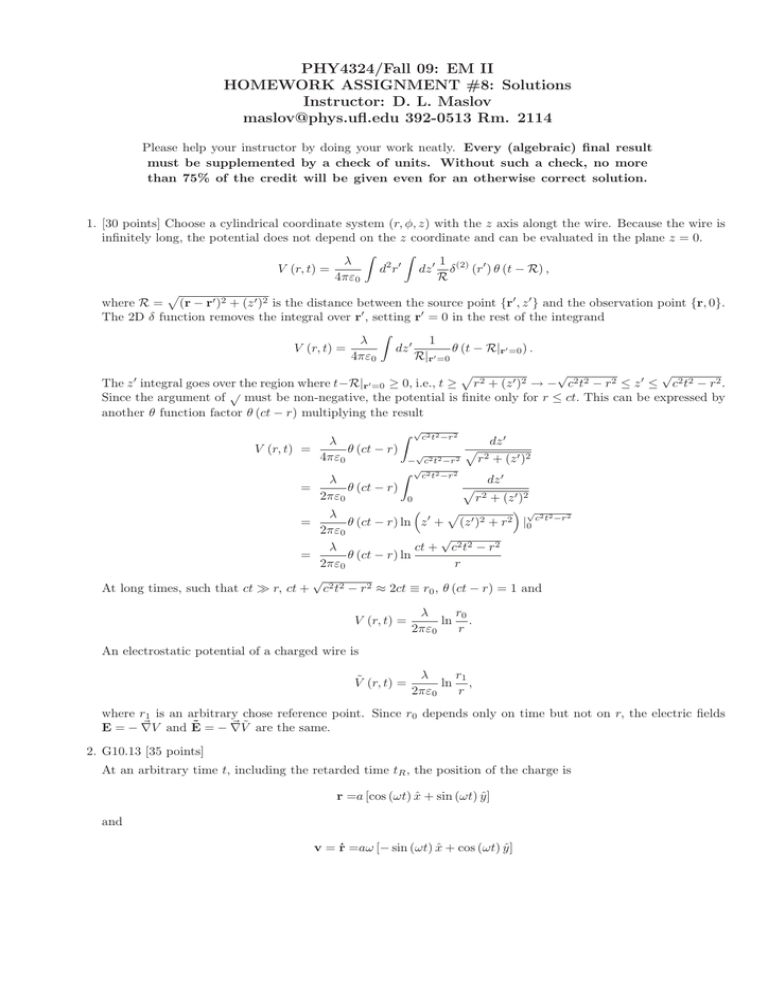
PHY4324/Fall 09: EM II
HOMEWORK ASSIGNMENT #8: Solutions
Instructor: D. L. Maslov
maslov@phys.ufl.edu 392-0513 Rm. 2114
Please help your instructor by doing your work neatly. Every (algebraic) final result
must be supplemented by a check of units. Without such a check, no more
than 75% of the credit will be given even for an otherwise correct solution.
1. [30 points] Choose a cylindrical coordinate system (r, φ, z) with the z axis alongt the wire. Because the wire is
infinitely long, the potential does not depend on the z coordinate and can be evaluated in the plane z = 0.
Z
Z
λ
1
V (r, t) =
d2 r′ dz ′ δ (2) (r′ ) θ (t − R) ,
4πε0
R
p
where R = (r − r′ )2 + (z ′ )2 is the distance between the source point {r′ , z ′ } and the observation point {r, 0}.
The 2D δ function removes the integral over r′ , setting r′ = 0 in the rest of the integrand
Z
λ
1
V (r, t) =
dz ′
θ (t − R|r′ =0 ) .
4πε0
R|r′ =0
p
√
√
The z ′ integral goes over the region where t−R|r′ =0 ≥ 0, i.e., t ≥ r2 + (z ′ )2 → − c2 t2 − r2 ≤ z ′ ≤ c2 t2 − r2 .
√
Since the argument of must be non-negative, the potential is finite only for r ≤ ct. This can be expressed by
another θ function factor θ (ct − r) multiplying the result
λ
θ (ct − r)
V (r, t) =
4πε0
Z
λ
θ (ct − r)
2πε0
Z
=
√
c2 t2 −r 2
√
− c2 t2 −r 2
√
c2 t2 −r 2
dz ′
p
r2 + (z ′ )2
dz ′
p
r2 + (z ′ )2
√22 2
p
λ
=
θ (ct − r) ln z ′ + (z ′ )2 + r2 |0 c t −r
2πε0
√
ct + c2 t2 − r2
λ
θ (ct − r) ln
=
2πε0
r
√
At long times, such that ct ≫ r, ct + c2 t2 − r2 ≈ 2ct ≡ r0 , θ (ct − r) = 1 and
0
V (r, t) =
r0
λ
ln .
2πε0
r
An electrostatic potential of a charged wire is
Ṽ (r, t) =
λ
r1
ln ,
2πε0
r
where r1 is an arbitrary chose reference point. Since r0 depends only on time but not on r, the electric fields
~ and Ẽ = − ∇
~ Ṽ are the same.
E = − ∇V
2. G10.13 [35 points]
At an arbitrary time t, including the retarded time tR , the position of the charge is
r =a [cos (ωt) x̂ + sin (ωt) ŷ]
and
v = ṙ =aω [− sin (ωt) x̂ + cos (ωt) ŷ]
2
Of course, v · r =0, as it should be for a circular motion. The radius-vector connecting the position of the charge
and a point at distance z above the plane of the circle is
~ = z ẑ − r
R
and its magnitude
q
p
2
R = z 2 + |r| = z 2 + a2 .
The retarded time is found from an equation
c(t − tR ) = R →
√
tR = t −
z 2 + a2
.
c
The scalar and vector potentials are given by
V (r, t) =
A (r, t) =
q
1
4πε0 R (tR ) 1 −
1
∧ R )·v(tR )
R(t
c
q v (tR ) 1
4πε0 c2 R (tR ) 1 −
1
∧ R )·v(tR )
R(t
c
,
where all quantities on the right-hand-side are evaluated at tR . Scalar product
∧ (tR ) ·v (tR ) = R
~ (tR ) ·v (tR ) /R (tR ) = (z ẑ − r) · v/R (tR )
R
= (0 − r · v)/R (tR ) = (0 − 0)/R (tR ) = 0,
which, of course, can be seen just from the geometry. The scalar potential is, therefore, the same as that of a
stationary charge
V (r, t) = V (r) =
q
1
√
,
4πε0 z 2 + a2
while the vector potential depends on time through the velocity
A (r, t) =
=
1
q aω [− sin (ωtR ) x̂ + cos (ωtR ) ŷ]
√
4πε0
c2
z 2 + a2
i
h
h
h
√
z 2 +a2
x̂ + cos ω t −
c
q aω − sin ω t −
√
z 2 +a2
c
c2
4πε0
i i
ŷ
1
√
2
z + a2
3. G10.18 [35 points]
From (10.64),
E (r,t) =
2
R
q
2
∧ × (u × a) ,
3 c − v u+R
4πε0 ~
R·u
∧
∧ = x̂. Then,
where u =cR−v.
For a linear motion, v =vx̂, a = ax̂, and, for a point to the right of the charge, R
~
u = (c − v) x̂, u × a = 0, and R · u =R (c − v) , and
E =
q
R
c2 − v 2 (c − v) x̂
3
4πε0 R3 (c − v)
2
=
(c − v) (c + v)
c+v
q
q
x̂ =
x̂.
3
4πε0 R2
4πε0 R2 c − v
(c − v)
Since the electric field is along the line of motion,
1∧
B= R
× E =0.
c
3
∧ = −x̂ , u = − (c + v) x̂, R
~ · u =R (c + v) , and
For a point to the left of the charge, R
q
R
E = −
c2 − v 2 (c + v) x̂
4πε0 R3 (c + v)3
c−v
q
x̂,
= −
4πε0 R2 c + v
B = 0.
4. Bonus: G10.16 [30 points]
Equation for the retarded time
|r − w (tR )|
tR = t −
c
q
2
where r =xx̂ abd x > w so that |r − w (tR )| = x − b2 + (ctR ) > 0. Re-write the equation as
q
2
c (t − tR ) + x = b2 + (ctR )
and square it. This gives
2
2
2
2
2
c2 (t − tR ) + 2xc (t − tR ) + x2 = b2 + (ctR )
(ct) − 2c2 ttR + (ctR ) + 2xc (t − tR ) + x2 = b2 + (ctR ) →
2
tR =
and
b2 − (x − ct)
.
2c (x − ct)
2
t − tR = t −
=
b2 − (x − ct)
2c (x − ct)
2
2ct (x − ct) − b2 + (x − ct)
2c (x − ct))
2
=
Now, we re-write the Lienard potential as
V (r, t) =
x2 − b2 − (ct)
2c (x − ct)
c
q
4πε0 cR (tR ) − R (tR ) ·v (tR )
amd notice that cR (tR ) − R (tR ) ·v (tR ) = R (tR ) (c − v (tR )) while R (tR ) = c (t − tR ) . The velocity is along
the x axis and its magnitude is given by
v (tR ) =
ctR
dw
c2 tR
=
|t=tR = q
.
dt
(tR − t) + x/c
2
b2 + (ctR )
Therefore,
cR (tR ) − R (tR ) ·v (tR ) = c (t − tR ) (c − v (tR ))
tR
= c2 (t − tR ) 1 −
(tR − t) + x/c
x − ct
= c (t − tR )
(tR − t) + x/c
2
= c
x2 − b2 − (ct)
x − ct
2c (x − ct) (tR − t) + x/c
2
2
=
1 x2 − b2 − (ct)
1 x2 − b2 − (ct)
=
2 (tR − t) + x/c
2 − x2 −b2 −(ct)2 + x/c
2c(x−ct)
=
x2 − b2 − (ct)
c (x − ct) .
b2 + (x − ct)2
2
4
Finally, substituting the last result into V, we obtain
V (r, t) =
q
b2 + (x − ct)2
1
.
4πε0 x − ct x2 − b2 − (ct)2
The vector potential
A =
1
(tR − t) + x/c
ctR
q
v
V =
2
2
c
4πε0 c (tR − t) + x/c c (t − tR )
x − ct
2
=
q
tR
1
q
1 b2 − (x − ct) 2c2 (x − ct)
=
2
2
4πε0 c x − ct t − tR
4πε0 c x − ct 2c (x − ct) x2 − b2 − (ct)2
2
=
q
1
b2 − (x − ct)
.
4πε0 c x − ct x2 − b2 − (ct)2
